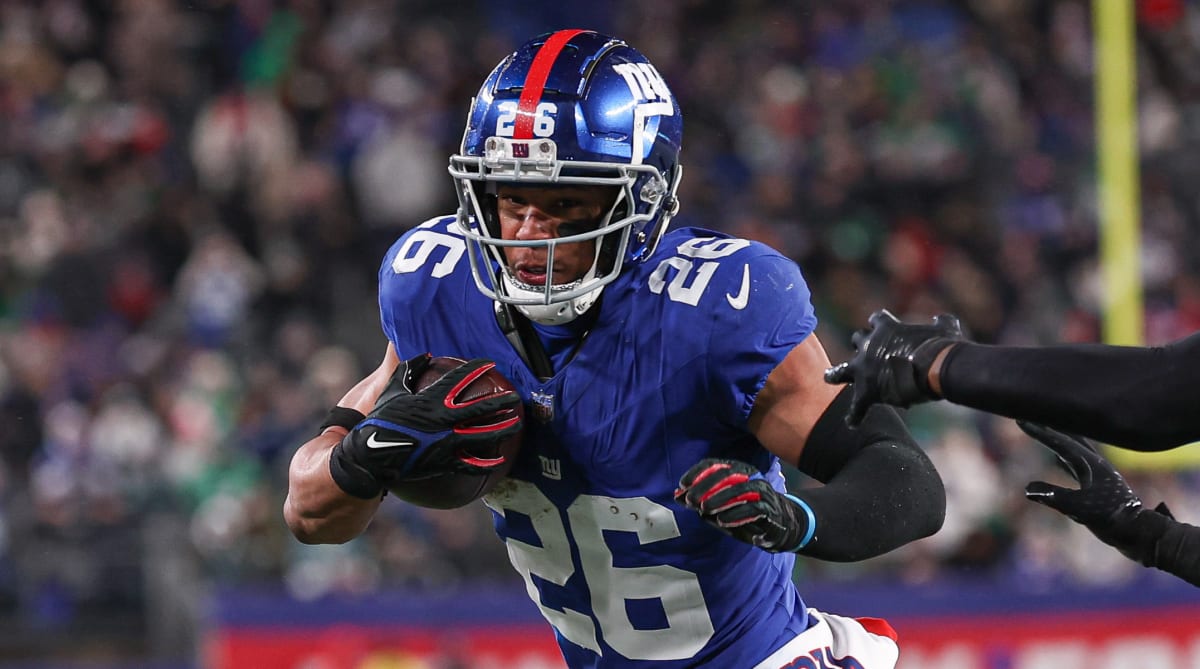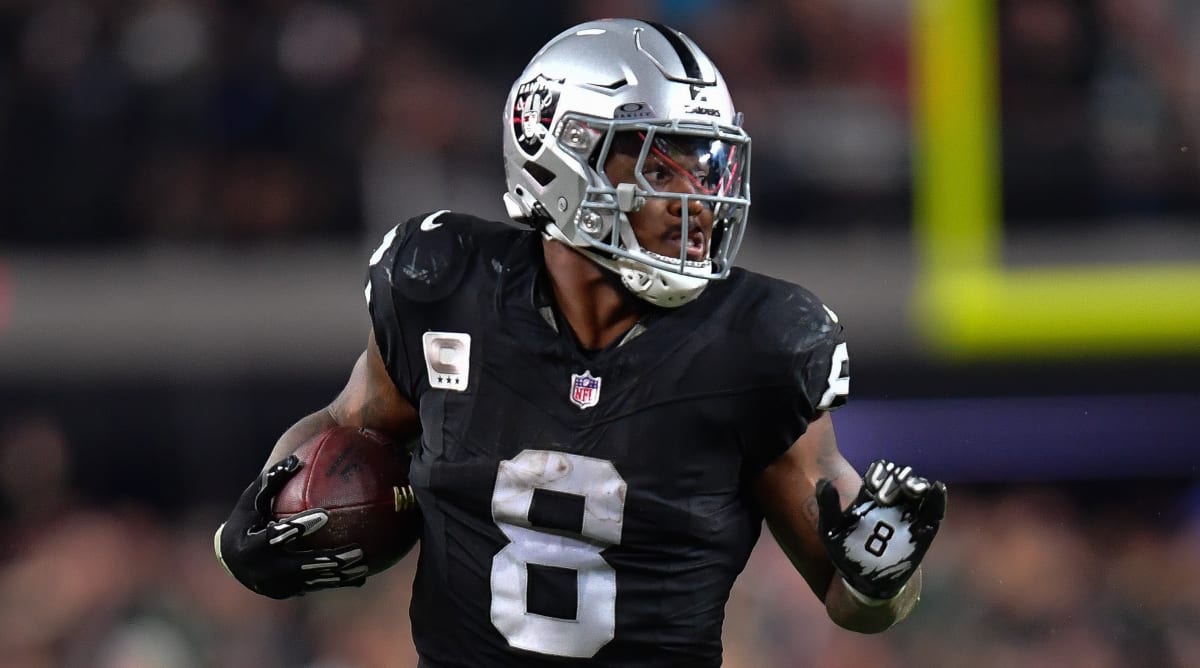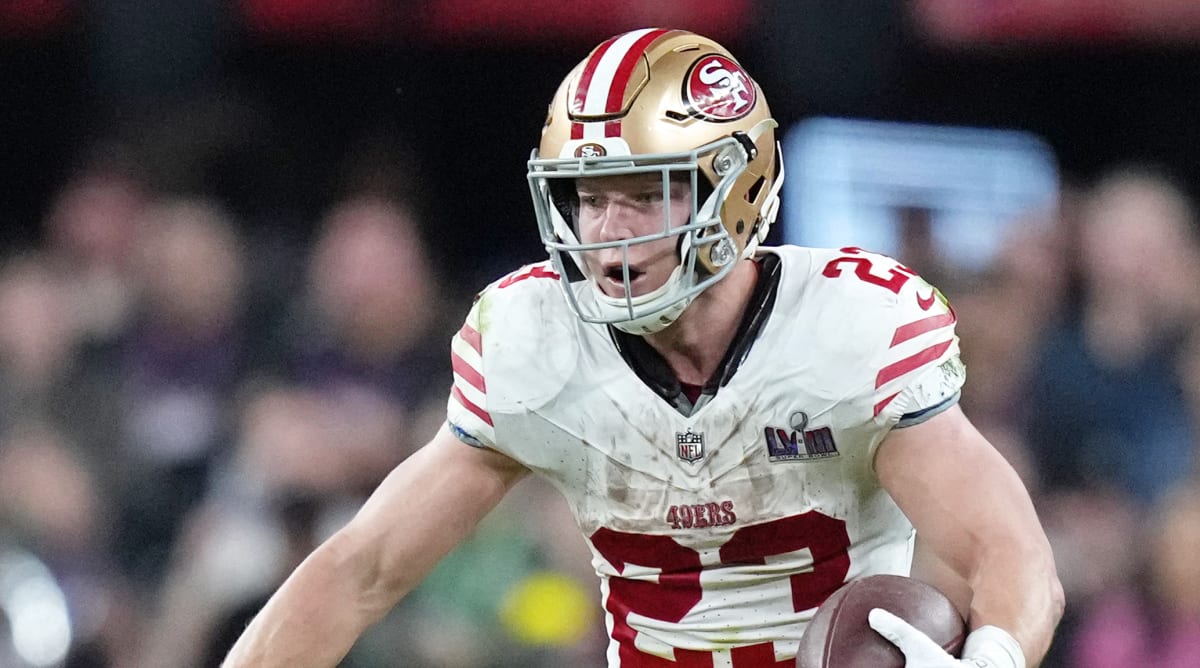If running back pay is ever going to rebound, this is the year.
The team that carries the NFL’s biggest contract at the position played in the Super Bowl. The draft is lacking, with perhaps the best tailback in this year’s class rehabbing a torn ACL and without a real first-rounder to be found in the bunch. And the free-agent group, now untethered from franchise tags, is loaded with well-pedigreed bellcows.
Put the 1990s equivalents of Saquon Barkley, Derrick Henry and Josh Jacobs on the market 30 years ago, and you’d have a feeding frenzy for their services. As it stands now, those guys probably won’t get half of what a top receiver does.
And if they do, it’d qualify as a market correction.

Vincent Carchietta/USA TODAY Sports
“The game has evolved and changed,” ex-Vikings GM Rick Spielman told me over the weekend as he reminisced about the old days. “Back then, all of a sudden, these quarterbacks coming out are more athletic than they were through the ’90s. Everybody was questioning, Will an athletic quarterback be able to stay healthy? It’s the same thing—the game has evolved.”
Spielman’s history can draw a roadmap for that evolution.
He got his start in the NFL as a BLESTO scout with the Lions, and in his second year the team rode its legend of a tailback, Barry Sanders, all the way to the NFC title game, the only in franchise history until this year. Then, he went to Miami, where he traded for Ricky Williams, a rugged, old-school back who became the best player on a playoff team. And we all know what Adrian Peterson and Dalvin Cook meant to his more recent Vikings teams.
Those Lions teams were, more or less, like everyone else in the NFL in the 1990s, either in possession of a back who was the focal point of the offense, or in search of one. Decades later, the Minnesota teams that Peterson led were outliers in being built around a tailback, and the ones Cook played for used him as far more than just a ballcarrier.
Fair or not, general perception in the NFL holds that you can get by in pro football without having a great player at the position—and that perception isn’t new. It’s been building for more than two decades, to the point now where only a kicker has a lower franchise tag number than a running back. And so it’s that environment that Barkley, Jacobs and Henry, as well as Austin Ekeler, Tony Pollard and D’Andre Swift, are going out into this week.
Will they turn the tide and score top-of-the-market contracts?
It’d be hard to count on that.
The free-agent legal-tampering period kicks off at noon ET Monday, and we’ve already started grading a few moves. But we have you covered here with the running backs, and everywhere else in the takeaways. Over there, you’ll find …
• Why Kirk Cousins stands alone as the NFL’s pivotal free agent this week.
• How Chris Jones’s big gamble in negotiating with the Chiefs paid off.
• Where things are headed, monetarily, at positions such as safety and linebacker.
But we’re starting with today’s NFL running back problem. Or maybe more accurate, the running backs’ problem in today’s NFL, which relates back to the three market conditions we detailed above.

Gary A. Vasquez/USA TODAY Sports
So it’d be one thing if this year’s draft class being light on running backs was an aberration.
Very clearly, it isn’t one.
Over the past 10 draft cycles, just 14 running backs have been drafted in the first round (Barkley and Jacobs are two of them), with six landing in the top 10. Through the 10 drafts of the 1990s, conversely, 34 backs went in the first round with a dozen in the top 10.
There are a number of factors at work there, and it starts at the grassroots level of the game where more kids are being introduced to the game through flag football, more youth tackle teams are throwing the ball, and more athletes are gravitating toward being quarterbacks and receivers, with tailback no longer the game’s golden-boy position.
“The kids see it as, What’s the easiest way to touch the ball and score touchdowns?” ex-Commanders and Panthers coach Ron Rivera says. “It’s to throw or catch it.”
Rivera is, in many ways, like Spielman. As a player, he counted the great Walter Payton among his teammates. When he became the head coach in Carolina, DeAngelo Williams and Jonathan Stewart were focal points of an offense built to leverage all that Cam Newton brought to the table athletically, and he later drafted Christian McCaffrey with the eighth pick.
He built around running backs, and did it in an era where fewer teams did things that way. And, yet, when I asked him where he’d tell his son to play, if that son was an elite athlete and, say, 6’1” and 200 pounds, Rivera didn’t miss a beat.
“I would tell him I'd play slot—learn to be the slot,” Rivera says. “Learn to be that inside guy. Why? Because that inside guy does what? Look at Deebo Samuel. Look at Curtis Samuel. Those guys touch the ball.”
In a previous era, those two probably would’ve been tailbacks, especially at their size.
Instead, they were groomed to be do-everything weapons, and on different levels it has paid off for both. Deebo Samuel scored a three-year, $73.5 million extension after his first three years in the league, showing he was a legit receiver who could moonlight in the backfield. All the same, Curtis Samuel’s versatility made him an attractive B-level free agent receiver. The three-year, $34.5 million deal he signed in 2021, following Rivera from Carolina to D.C., was middling for a wideout. It’d qualify as top dollar for a tailback.
And so just the decisions by the two Samuels (no relation) to pursue football as receivers were signs of the time. They were also right business decisions for each.
What’s more, Curtis Samuel is now headed into his eighth NFL season pursuing a third contract, and Deebo Samuel in going into his sixth year and still going strong, which is another reason why receivers get second contracts more often—not only are they less beat up than backs, they also stand to hold up for longer.
Spielman explained how his Vikings had analytics on what they called the “wall age,” when a player entered into the 75th percentile among the oldest players at his position, and the “critical age,” when the player’s production falls off a cliff. The data that Minnesota compiled showed that running backs were markedly younger in both categories when they hit those junctures.
Spielman had an outlier in Minnesota, of course. But counting on what Peterson did regularly would be, he knew, a fool’s logic. “Adrian was an alien,” he says with a laugh. “Adrian had his best year coming off an ACL. Most guys, it takes them an extra year to get back. Never seen anything like it. He was an alien.”
Another GM shared that his analytics showed that the average high-level running back’s decline commences at 27. “Those are examples you have to listen to,” the exec says.
And, obviously, adding a shallower pool of elite players at the position to the longevity issue creates an environment where teams go elsewhere with their money.
So how is someone like McCaffrey a real outlier, and worthy of being the eighth pick in the draft, and then the four-year, $64 million extension the Panthers signed him to in 2020 in this RB-phobic environment?
It’s not one thing he does, but everything he does.
Rivera recalled scouting McCaffrey in 2017, and seeing him return kicks and punts, and run routes like a receiver, and catch the ball out of the backfield, before looking and finding a pretty crazy stat—he was as effective running between the tackles as anyone in college football. “We got criticized—Oh, he’s not going to be able to run inside,” Rivera says. “Oh, yes he can.”
And in his ability to do that, and run routes and read a defense such as a receiver, he could cause a math problem for every defense he faced.
Stanford, and later Carolina and San Francisco, could put him in the huddle and essentially have him counted at two positions. Then, if the defense came out in base personnel, the coaches could split McCaffrey out and get him on a linebacker, who would have no chance at covering a slot receiver (which is what McCaffrey would basically become). And if the defense came out in nickel, the coaches could have McCaffrey run downhill into the box.
“You create mismatches moving him around,” Rivera says. “The ability to understand the passing game that Christian had, that he could line up as a wide receiver, read the coverage, and then run a route, that corresponds with it."
“It’s like a shell game,” says Spielman, just after conceding about McCaffrey, “He’s a unicorn.”

Kirby Lee/USA TODAY Sports
McCaffrey creates value in a forward thinking offense such as Kyle Shanahan’s because he can do what Samuel does in so many ways—only instead of being the receiver moonlighting at tailback, he’s the opposite. And, thus, when the 49ers break the huddle and play that shell game, the defense is already on its heels trying to figure out just where everyone is going.
Of course, there are examples of old-school backs that have continued to thrive.
Henry would probably be the best example—but where it once took buy-in to invest in and put third and fourth receivers on the field, now it takes similar commitment to veer from the NFL norm and build an offense around a back like that. The Titans have, and it’s allowed them to ride out some quarterbacking tumult over the years, but there aren’t many other examples where an old-school back would find a natural home.
And if the GMs in that environment are drafting for what their coaches are building, as they should, the schemes of today will naturally hurt the value of the traditional back that doesn’t bring all that McCaffrey does to the table.
“I was with Zim [Mike Zimmer], and you're trying to build the philosophy around what the coach wants,” Spielman says. “Adrian was probably our best player. At the time when Dalvin was rolling, [he] was probably our best player on offense. We were always geared that way, at least, the philosophy was to have the running back be the main focal point.”
Which made the Vikings different, and explains why Spielman had to approach things a little differently, too.
So that brings us back to the crop of free agent backs that’ll hit the market at 4 p.m. ET Wednesday when free agency officially kicks off.
Barkley and Jacobs are coming off tags, going into Years 7 and 6 of their careers, respectively. Henry and Ekeler are seeking third contracts. Swift’s looking to benefit from a big bounce-back year after three mostly up-and-down, and injury crossed seasons in Detroit.
Each has his warts, be it injury, age, inconsistency or a combination of the three. But all five have shown an ability to be top backs. All five were counted on as lead dogs for their teams. All five have earned their shot at the market here, and McCaffrey has shown, in the current day, that a team can make a Super Bowl with a running back as its best skill-position player.
“He most certainly can be,” Rivera says. “It’s one of those things [where] you have to continually feed him. I love the diversity of what they do in San Francisco and it suits them very, very well. Unfortunately for them, they came up against Patrick Mahomes—let's be honest about that. The way they played offense, if they played anybody else, they probably win. That’s what I saw. … Christian is the perfect fit.”
And on top of that, with the way the market has flattened (Peterson made more than $13 million per year on a deal he signed in 2011, which would make him the fourth highest paid back in the NFL in ’24), even a big deal for a back could be seen as a bargain.
Let’s say, for example, that Barkley gets $12 million per year, which would put him in the top five at the position in APY (average per year). He’d then be making a little more than Jakobi Meyers and Allen Lazard did as free-agent receivers last year, and a lot less than Hunter Renfrow and Courtland Sutton, who have been trade fodder at receiver the past few years.
It's safe to say Tennessee didn’t regret the four-year, $50 million deal it gave Henry in 2020, nor would the Browns have any misgiving on paying Nick Chubb, even with his recent knee injury.
Maybe, for those reasons, the Texans wouldn’t regret giving Barkley a free-agent windfall, or the Chargers and Ravens wouldn’t regret doing it to acquire Jacobs or Henry.
The problem is it’s often seen as too easy to find a great running back. Indeed, just as the Niners had McCaffrey, the Chiefs beat them with former seventh-rounder Isiah Pacheco, who beat out former first-rounder Clyde Edwards-Helaire for playing time. All the same, where the Lions used a first-rounder to draft Jahmyr Gibbs, the Ravens got by without J.K Dobbins, who cost them a second-round pick.
So there is no easy answer in this day and age. Which may be why everyone comes up with their own—and why it’s so uncertain whether guys such as Jacobs, Barkley and Henry will find the teams they’re looking for this week.